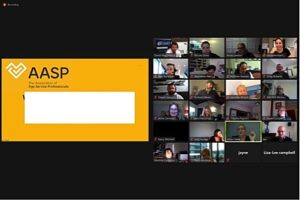Uncategorised
AASP Team Learns About The Interface Between NDIS and Aged Care

The Australian Association of Service Providers (AASP) met for their last quarterly meeting of the year on December 1st 2020.
New members Gabrielle Porter-Ryan, Peter Tribolet, David Miles, Lucy Duggan and Rachael Wass were welcomed. The addition of these members brings the total membership to 63.
Guest Speaker Russell Shewin, General Manager NDIS Division at Health Care Australia (HCA), spoke on the topic Interface Between NDIS and Aged Care.
Costs and Savings
Russell explained that the scheme started with $6.9 billion dollars invested in disability support which will increase to approximately $22 billion at the end of the roll out of the scheme. This is, infact, a cost saving for the government on the original cost estimates for disability support without the NDIS scheme. Those estimates suggest it would have cost the government an additional $30 billion by 2035. The cost savings are obtained by increasing the contribution by people with a disability and their supports, thus reducing reliance on the government.
Eligibility Criteria for NDIS
- Have a permanent disability that significantly affects a person’s ability to take part in everyday activities or a developmental delay
- Be less than 65 years old when first accessing the NDIS
- Be an Australian citizen, hold a permanent visa or a Protected Special Category visa, and
- Live in a part of Australia where the NDIS is now available.
The NDIS funds support in three broad categories. They are:
1, Core – supports daily living activities. Can be flexible but not transferable to other categories.
2, Capital – investment in assistive technologies, equipment, home or vehicle modifications or Specialist Disability Accommodation (SDA). Must be in participant’s plan.
3, Capacity Building – supports to enable building of independence and skills.
There are delineations between what the NDIS supports and other government departments support. In education the NDIS supports student’s self-care at school, specialised training of staff for the student’s particular personal support needs, specialised transport, transportable equipment (eg: wheelchair), non-educational therapies delivered during school time (agreed to by parents and school). In health the NDIS supports home modifications, personal support, skills learning to gain more independence, allied health and other therapies due to a person’s disabilities, prosthetics and artificial limbs, aids and equipment and therapeutic and behaviour supports for a person with psychosocial disability.
The Players
The NDIS is run by the National Disability Insurance Agency (NDIA) This body decides if a participant is eligible and how much funding they will receive. The Quality and Safeguard Commission oversee the scheme to ensure national consistency and regulate NDIS providers. They promote safety and quality of service, resolve problems and identify areas for improvement.
Participants’ main contact for the service is their Local Area Coordination (LAC) who help them to understand and access the NDIS. They also assist with developing and implementing their plans through introducing the participants to government services, local supports and services and community activities. The LAC’s goal is to gain inclusiveness and accessibility for people living with a disability in their remit area. For young children 6 years and under with a disability or developmental delay Early Childhood Early Interventions help their families to connect to services such as community health services, playgroups or other suitable activities in the area.
Uptake of NDIS
The uptake of NDIS support has grown from just 7,285 active participants in 2013-14 to 412,543 by September 2020. People with a disability aged under 65 in residential aged care on NDIS has also increased from only 841 compared to 6,156 not on NDIS as at June 2018 to 3,708 on NDIS compared to 4,860 not on NDIS as at June 2020.
The goal for 2022 is –
- for no-one under the age of 45 to be living in residential aged care.
- no-one under 65 be entering residential aged care.
The goal for 2025 is –
- for no-one under 65 to be living in residential aged care.
NDIS Financial Plans
The way in which NDIS financial plans are managed can vary between self-managed, partly self-managed, plan managed or agency managed. Interestingly, the larger percentage of self-managed plans are for children (approximately a third) with it dropping dramatically for adults (over 18). Approximately 50% of all adult age groups use plan managed, with approximately 33% using agency managed. 19-24 year olds use 13% self-managed and 10% part self-managed plans, with it dropping at age 25 to 9% self-managed. It hovers around 7 to 8% self-managed and 8 to 9% part self-managed in the 35 to 64 age group. Then at 65+ it jumps a bit to 11% part self-managed and 8% self-managed.
Russell provided some resources for further information. AASP thank him for his helpful and informative presentation.
https://www.myagedcare.gov.au/sites/default/files/2020-01/continuity-of-support-client-handbook.pdf
If you are wanting to become a member of AASP head to https://www.aasp.org.au/membership/
